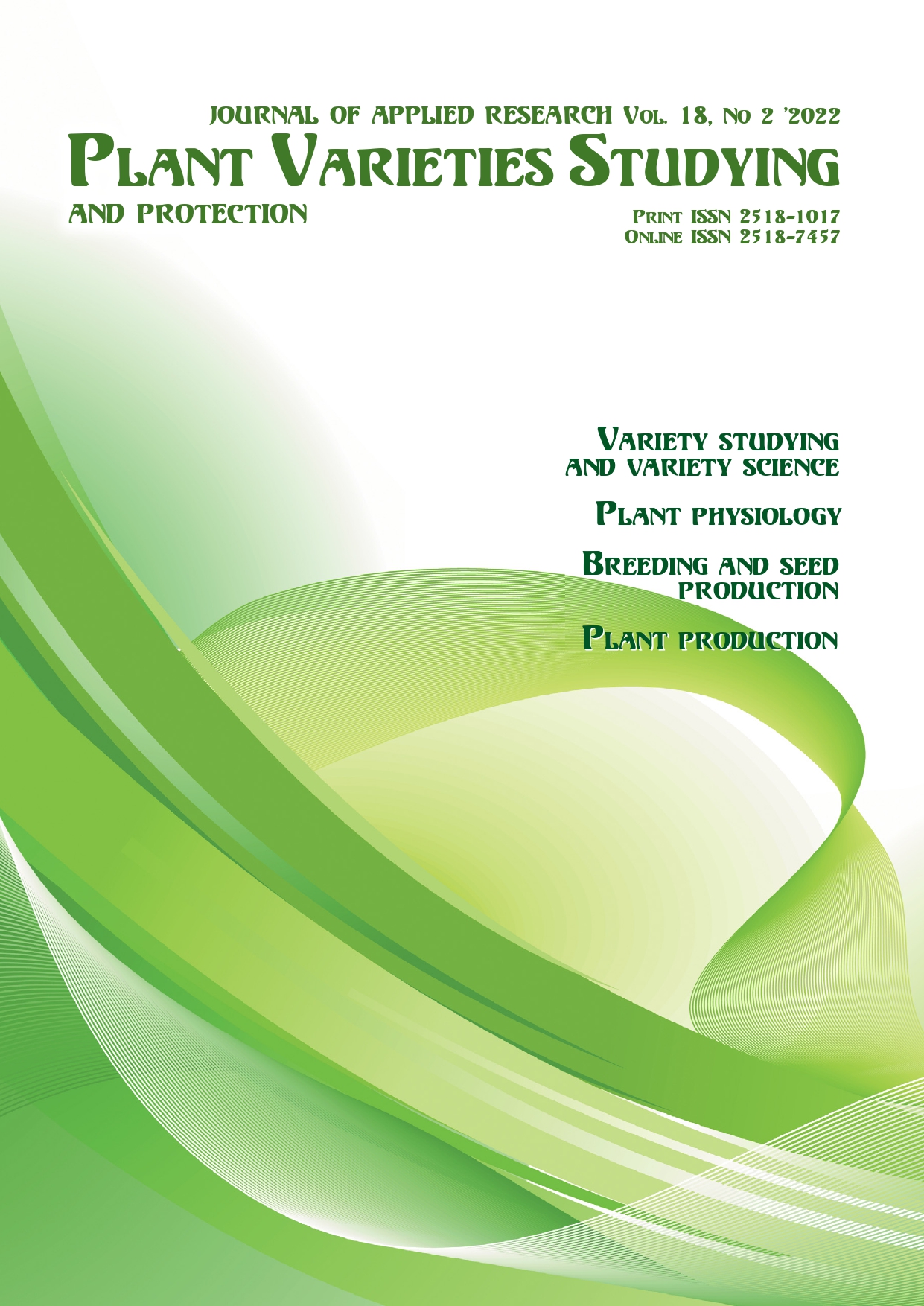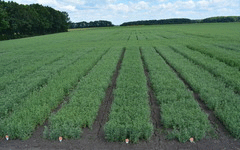The origin of Herbaceous hybrid Group peony cultivars of the M. M. Gryshko National Botanical Garden of NAS of Ukraine collection and the prospects for their use
DOI:
https://doi.org/10.21498/2518-1017.18.2.2022.265175Keywords:
interspecies hybridization, crossing, floweringAbstract
Purpose. To analyze the origin of the Herbaceous Hybrid Group peony cultivar collection of the M. M. Gryshko National Botanical Garden (NBG) National Academy of Sciences of Ukraine (NAS) and to determine the prospects for their use in breeeding work and decorative horticulture.
Methods. The object of research was peonies of the Herbaceous Hybrid Gp of the NBG peony collection. The plants are grown on sunny open experimental and exposition plots of the NBG. Cultivars studies and phenological observations of plants were carried out during 2012–2022.
Results. Varietal diversity of Herbaceous Hybrid Gp peonies of the NBG collection was analyzed by origin. The analysis showed that 122 varieties were created by US breeders, of which the Saunders breeding is represented by the largest number of varieties in the collection. 38 varieties are of Ukrainian breeding and created in the NBG. The analysis of hybrids obtained by distant crosses made it possible to identify combinations that give fertile offspring and to create promising double and triple hybrids. For decorative horticulture, 165 varieties of world and domestic breeding are recommended. They were grouped into four groups by flower color and two groups by the beginning of flowering. Plants of the early group start flowering before May 22 (± 4 days). The flowering of the late group of varieties occurs at the beginning of the flowering of the variety ‘Red Charm’ (May 22 ± 4 days) and later.
Conclusions. For more than 50 years of introductory work with peony Herbaceous Hybrid Gp, 133 varieties of world breeding were tested at NBG. The main number of varieties was included in the collection in the first years of the 21st century. A comparative study of new varieties showed that most of them are sterile. Varieties ‘Dreamtime’, ‘Greenland’, ‘Quitzin’, ‘Lavender Whisper’, ‘Lemon Chiffon’, ‘Pastelegance’, ‘Pastelorama’, ‘Salmon Dream’, ‘Sunny Boy’, ‘Sunny Girl’, ‘Sunny Day’, ‘The Mackinac Grand’, ‘Vanilla Schnapps’, ‘Triphena Parkin’, ‘Pink Vanguard’, ‘Lavender Whisper’, were fertile and can be successfully used in the hybridization process. It was revealed that the source of early flowering of varieties created in the NBG was introduced wild species of herbaceous peonies: P. peregrina, P. wittmanniana, P. arietina. Peonies with double or semi-double flowers can be obtained by using P. officinalis ‘Rubra Plena’ with double flowers as a maternal component, and P. lactiflora varieties (‘President Taft’, ‘La Pionce’, ‘Lord Kitchener’, ‘Adolphe Roussean’, ‘M-lle Janne Riviere’) as paternal one also with terry flowers
Downloads
References
Gorobets, V. F. (2015). Piony (biologiya, selekciya, sorta) [Peonies (biology, breeding, varieties)]. Kyiv: Veles. [In Russian]
Rakhmetov, D. B., Zaimenko, N. V., Gaponenko, M. B., Buyun, I. I., Rubtsova, O. L., Ivannikov, R. V., … Gasnyuk, M. O. (2019). Naukovi obiekty NBG imeni M. M. Hryshka NAN Ukrainy, shcho stanovliat natsionalne nadbannia [Scientific objects of the M. M. Gryshko NBG of the National Academy of Sciences of Ukraine, forming the national heritage]. Kyiv: Palyvoda A. V. [In Ukrainian]
Ministry of Agrarian Policy and Food of Ukraine. (2022). State register of plant varieties suitable for dissemination in Ukraine in 2022. Kyiv: N.p. Retrieved July 20, 2022, from https://minagro.gov.ua/file-storage/reyestr-sortiv-roslin [In Ukrainian]
Gorobets, V. F., & Shcherbakova, T. O. (2021). Phenological features of the growth and development of Itoh Group peony cultivars in the conditions of the M. M. Gryshko National Botanical Garden of the National Academy of Sciences of Ukraine. Plant Varieties Studying and Protection, 17(1), 14–20. doi: 10.21498/2518-1017.17.1.2021.228202 [In Ukrainian]
Gorobets, V., & Scherbacova, T. (2017). Old Peony Cultivars in the Collection of the M. M. Gryshko National Botanical Garden of NAS of Ukraine. Agrobiodiversity For Improving Nutrition, Health and Life Quality, 1, 146–150. doi: 10.15414/agrobiodiversity.2017.2585-8246.146-150
Paeonia L. (n.d.). In Plants of the World online. Retrieved July 20, 2022, from http://www.plantsoftheworldonline.org/taxon/urn:lsid:ipni.org:names:329475-2
Li, P., Shen, J., Wang, Z., Liu, S, Liu, Q., Li, Y., … Xiao, P. (2021). Genus Paeonia: a comprehensive review on traditional uses, phytochemistry, pharmacological, activities, clinical application, and toxicology. Journal of Ethnopharmacology, 269(2), Article 113708. doi: 10.1016/j.jep.2020.113708
Hao, L., Ma, H., Teixeira da Silva, J., & Yu, X. (2016). Pollen Morphology of Herbaceous Peonies with Different Ploidy Levels. Journal of the American Society for Horticultural Science, 141(3), 275–284. doi: 10.21273/JASHS.141.3.275
Yang, L., Zhang, J., Teixeira da Silva, J., & Yu, X. (2017). Variation in Ploidy and Karyological Diversity in Different Herbaceous Peony Cultivar Groups. Journal of the American Society for Horticultural Science, 142(4), 272–278. doi: 10.21273/JASHS04015-17
Zhou, S., Xu, C., Liu, J., Yu, Y., Wu, P., Cheng, T., & Hong, D. (2021). Out of the Pan-Himalaya: Evolutionary history of the Paeoniaceae revealed by phytogenomics. Journal of Systematics and Evolution, 59(6), 1170–1182. doi: 10.1111/jse.12688
Yang, Y., Sun, M., Li, Sh., Chen, Q., Teixeira da Silva, J., Wang, A., … Wang, L. (2017). Germplasm resources and genetic breeding of Paeonia: a systematic review. Horticulture Research, 107(7), Article 107. doi: 10.1038/s41438-020-0332-2
Kamenetsky, R., & Dole, J. (2012). Herbaceous peony (Paeonia): Genetics, Physiology and cut flower production. Floriculture and Ornamental Biotechnology, 6(1), 62–67.
American Peony Society. (n.d.). Peony Registry. Retrieved July 20, 2022, from https://americanpeonysociety.org/cultivars/peony-registry
Bulach, P. E. (2010). Teoriya i metody prognozirovaniya v introdukcii rasteniy [Theory and methods for prediction in plant introduction]. Kyiv: Naukova dumka. [In Russian]
Osadchyi, V. I., Kosovets, O. O., & Babichenko, V. M. (Eds.). (2010). Klimat Kyieva [Climate of Kyiv]. Kyiv: Nika-Tsentr. [In Ukrainian]
Bylov, V. N. (1978). Principles of variety-based comparative assessment of ornamental plants. In Introdukciya i selekciya tsvetochno-dekorativnykh rasteniy [Introduction and breeding of ornamental plants] (pp. 7–32). Moscow: Nauka. [In Russian]
Gorobets, V. F. (2008). Methodology for examination of peony varieties (Paeonia L.) for distinctness, uniformity and stability. In Metodyka provedennia ekspertyzy sortiv roslyn hrupy dekoratyvnykh na vidminnist, odnoridnist i stabilnist [Methodology for examination of plant varieties of the ornamental group for distinctness, uniformity and stability]. Retrieved July 20, 2022, http://sops.gov.ua/uploads/page/Meth_DUS/Method_decors_2022.pdf [In Ukrainian]
Shults, G. E. (Ed.). (1975). Metodika fenologicheskikh nablyudeniy v botanicheskikh sadakh SSSR [Methods of phenological observations in botanical gardens of the USSR]. Moscow: Publishing House of the USSR Academy of Sciences. [In Russian]
American Peony Society. (n.d.). Bloom Date Project. Retrieved July 20, 2022, from https://americanpeonysociety.org/learn/bloom-data-project/
Yang, Y., Li, B., Feng, Ch. Wu, Q., Wang, Q., Li, S., … Wang, L. (2020). Chemical Mechanism of Flower Color Microvariation in Paeonia with Yellow Flowers. Horticultural Plant Journal, 6(3), 179–190. doi: 10.1016/j.hpj.2020.04.002
Downloads
Published
How to Cite
Issue
Section
License
Copyright (c) 2022 Gorobets, V. F., Shcherbakova, T. O.

This work is licensed under a Creative Commons Attribution-ShareAlike 4.0 International License.
Starting in 2022, the copyright to the publication remains with the authors
Our journal abides by the CREATIVE COMMONS copyright rights and permissions for open access journals.
Authors, who are published in this journal, agree to the following conditions:
- The authors reserve the right to authorship of the work and pass the first publication right of this work to the journal under the terms of a Creative Commons Attribution License, which allows others to freely distribute the published research with the obligatory reference to the authors of the original work and the first publication of the work in this journal.
- The authors have the right to conclude separate supplement agreements that relate to non-exclusive work distribution in the form in which it has been published by the journal (for example, to upload the work to the online storage of the journal or publish it as part of a monograph), provided that the reference to the first publication of the work in this journal is included.

























 Ukrainian Institute for Plant Varieties Examination
Ukrainian Institute for Plant Varieties Examination  Селекційно-генетичний інститут
Селекційно-генетичний інститут Institute of Plant Physiology and Genetics of the National Academy of Sciences of Ukraine
Institute of Plant Physiology and Genetics of the National Academy of Sciences of Ukraine
 The National Academy of Agrarian Sciences of Ukraine
The National Academy of Agrarian Sciences of Ukraine